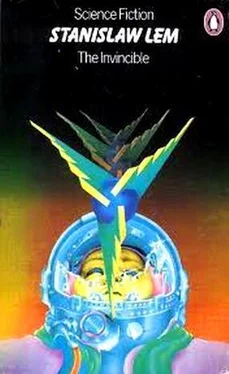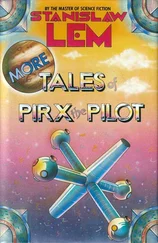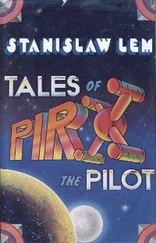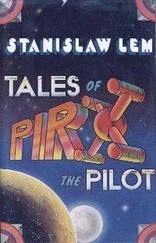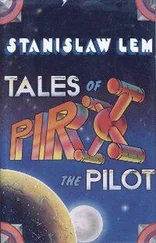Broza insisted on catching one of the fish. The probes pursued the shadows as they flitted about in the darkness of the ocean, shooting electrical charges at them. But the fish were incredibly agile; it took many misses before finally one of the creatures was stunned and could be grabbed by hooks lowered from the probes. The crew recalled the probe immediately to shore.
In the meantime, Koechlin and Fitzpatrick had guided another probe over the ocean, collecting samples of fibers that were drifting in the deeper layers of the sea. The men believed them to be a type of local algae. Finally they sent the probe all the way down to the ocean floor, which at this point reached a depth of 250 yards. Down below were strong currents that made remote-control steering rather difficult. The probe was constantly pushed off course and collided all the time with the rock heaps on the ground. With great effort some of the stones could finally be rolled over. Just as Koechlin had suspected, a whole colony of tiny cilia-covered creatures had been hiding underneath the shelter of the big stones.
After the two probes had safely returned to their base, the biologists began their task. In the meantime a hut had been erected where they could take off the bothersome respirator masks. Rohan, Jarg and the five other men ate their first hot meal that day.
For the rest of the day they were busy collecting mineral specimens, examining the radioactivity of the ocean floor, measuring the amount of insultation and carrying out the manifold tasks that were irksome yet had to be performed with accuracy if they wanted to obtain reliable results.
By dusk everything that they had set out to do had been achieved. Rohan felt a sense of accomplishment as he stepped to the microphone to answer Horpach’s call from the Invincible. He reported that the ocean was full of living organisms, all of which avoided coming anywhere close to the shore regions. Nothing unusual had been detected when they had dissected the one fish they had caught. The evolution of life on Regis III must have been going on for approximately several hundred million years. They had also discovered considerable amounts of green algae; this should account for the presence of the oxygen in the atmosphere. There was the same division of observed organic forms as on Earth and other planets, namely into flora and fauna. Also the skeletal structure of the vertebrates seemed to be typical. However, one organ had been found in the fish specimen for which no corresponding terrestrial structure was known to the examining biologists. This seemed to be a special organ of sense that reacted strongly to minute variations in a magnetic field.
Horpach ordered the crew to return immediately to the spacecraft. He closed the conversation by reporting an important item of news: they had apparently succeeded in discovering the place where the lost Condor had landed.
Despite the violent protests on the part of the biologists (who insisted they would need at least several weeks to complete their investigations), Rohan had the huts dismantled. The engines started and the column began its way back in a northwesterly direction. Rohan was unable to give any further details to his crew, who were eager to learn more about the Condor. He was certain, however, that it was advisable to hurry back, for he assumed that the commander would give out new assignments that most likely would supply them with more rewarding answers. Of course, the first step would consist of a thorough examination of the area where the Condor was supposed to have landed. Rohan drove as fast as the engines would permit. Their return trip was accompanied by a hellish noise as the caterpillar tracks rattled rapidly over the gravel ground, crunching and cracking and spewing out the stones in their path.
At the onset of darkness they switched on their big headlights; before their eyes the flickering light cones drew from the darkness huge, shapeless, apparently mobile silhouettes — which turned out to be nothing but big boulders, the last remaining remnants of an eroded mountain chain.
Several times they were forced to stop before some deep rifts in the basalt that had to be cautiously circumnavigated.
It was long past midnight when they finally sighted the body of the Invincible, shimmering in the distance like a festively illuminated metal tower. A great deal of activity was going on within the area of the energy field. Rows of vehicles were moving about, provisions and fuel were unloaded; groups of men were crowded below the ramp, which was lit up as bright as daylight by the huge Jupiter lamps. From a distance the returning men could hear the noise generated by the workers, busily scurrying about like so many ants in a bustling ant-heap. Now blue signal lights began to blink to indicate the spot where they could re-enter the energy screen. One after another, the vehicles of the returning expedition rolled into the protective hemisphere.
Hardly had Rohan jumped off his truck when he hailed one of the passing men, who he recognized as Blank. Rohan asked him what else had been found out about the Condor. But Blank had not even heard anything about the presumed discovery of the lost spaceship. There were only a few additional bits of information he could supply to Rohan. Before the satellites had burned up in the lower layers of the atmosphere they had managed to make some eleven thousand photographs. These had been transmitted and received by radio signals, which in their turn had been transferred onto specially prepared plates that were now in the cartographical cabin.
Rohan did not wish to waste any time. He ordered the cartographer Erett to come to his own cabin. While standing under a hot shower, Rohan quizzed Erett. He wanted to hear what had occurred on board the Invincible while he had been out on his expedition to the ocean shore. Erett was one of those who had carefully examined the incoming satellite photos for any trace of the vanished Condor. He had been one of the thirty men who had searched for this tiny grain of steel in the vast ocean of sand. Their group of experts had consisted of several planetologists, cartographers, radar observers and all pilots aboard the Invincible. For more than twenty-four hours they had alternately sifted through the incoming material and then noted down the coordinates of any suspicious spot on the planet. Unfortunately the commander’s report to Rohan had turned out to be incorrect: what they had believed to be the spaceship was nothing but an unusually tall rocky spire whose shadow had looked remarkably like that of a rocket. Thus the Condor’s fate remained in the dark as before.
Rohan wanted to report directly to the commander but he had already retired for the night, so Rohan went to his own cabin. Despite his exhaustion he could not fall asleep for a long time. Shortly after he awoke the next morning, he received a request from the astrogator via Ballmin, chief of the planetologists, to dispatch his entire material to the main laboratory. By ten o’clock Rohan felt so hungry — he had not yet had breakfast — that he took the elevator down to the mess hall for the radar observers. He was just drinking his coffee when Erett stormed in, rushing straight to Rohan’s table.
“Did you find the Condor?” Rohan asked when he saw the cartographer’s excited face.
“No, but we’ve detected something much bigger. Come along right away, please. The astrogator is waiting for you.”
It seemed as if the glassed-in cylinder literally inched its way up the elevator shaft. Nobody spoke to them when they arrived at the quiet darkened cabin. The humming of the relays could be heard and the automatic developer spat out shiny moist photos; but no one paid any attention. Two technicians were just pulling a projector out from behind a hinged door in the wall. Just before the technician switched off the light, Rohan managed to locate the white-haired cranium of the astrogator amid all the other heads. The next moment a silvery shimmering screen descended from the ceiling. Tense breathing was the only audible sound. Rohan got as close to the screen as possible. The rather fuzzy image (unfortunately only a black-and-white photo) showed a bare high plateau, surrounded by an irregular ring of small craters, jutting out from the landscape. On one side this tableland fell away steeply, as if sliced off by a giant knife. That was the shoreline, for the rest of the picture was filled by the even black expanse of the ocean. At some distance from this precipice Rohan noticed a mosaic of indistinct shapes that lay partially obscured under some low clouds and their shadows. No doubt about it, this peculiar structure with its blurry outlines could not be mistaken for any geological formation.
Читать дальше
